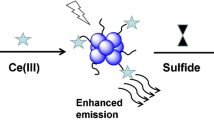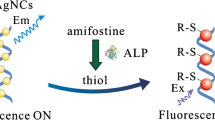Abstract
We have developed a sensitive chemiluminescent (CL) assay for cysteine. It is based on the use of water-soluble and fluorescent silver nanoclusters (Ag NCs) which are found to be able to strongly enhance the weak CL signal resulting from the redox reaction between Ce(IV) ion and sulfite ion. This enhancement is inhibited by cysteine under appropriate conditions. Taking advantage of this specific CL inhibition, a novel CL method for the sensitive and selective detection of cysteine was developed. This effect is interpreted in terms of an electronic energy transfer from excited state intermediate sulfur dioxide (originating from the CL reaction between Ce(IV) and sulfite ions) to the Ag-NCs. The latter become electronically excited and thus can act as a new source of emission. The method was applied to the determination of cysteine in the range from 5.0 nM to 1.0 μM, with a detection limit at 2.5 nM (S/N = 3).

In the presence of Ag NCs that can act as luminophors and energy acceptors, the weak CL signal resulting from the redox reaction between Ce (IV) ion and sulfite ion can be significantly enhanced, and this enhanced CL system can then be inhibited by cysteine under suitable conditions





Similar content being viewed by others
References
Gazit V, Ben-Abraham R, Coleman R, Weizman A, Katz Y (2004) Cysteine-induced hypoglycemic brain damage: an alternative mechanism to excitotoxicity. Amino Acids 26(2):163–168
Shahrokhian S (2001) Lead phthalocyanine as a selective carrier for preparation of a cysteine-selective electrode. Anal Chem 73(24):5972–5978
Lee JS, Ulmann PA, Han MS, Mirkin CA (2008) A DNA-gold nanoparticle-based colorimetric competition assay for the detection of cysteine. Nano Lett 8(2):529–533
Li L, Li B (2009) Sensitive and selective detection of cysteine using gold nanoparticles as colorimetric probes. Analyst 134(7):1361–1365
Shang L, Dong S (2009) Sensitive detection of cysteine based on fluorescent silver clusters. Biosens Bioelectron 24(6):1569–1573
Xie WY, Huang WT, Li NB, Luo HQ (2012) Design of a dual-output fluorescent DNA logic gate and detection of silver ions and cysteine based on graphene oxide. Chem Commun 48(1):82–84
Yang X, Guo Y, Strongin RM (2011) Conjugate addition/cyclization sequence enables selective and simultaneous fluorescence detection of cysteine and homocysteine. Angew Chem Int Ed 50(45):10690–10693
Li G, Yang J, Zheng X, Meng M, Cao J (2010) A novel electrogenerated chemiluminescence sensing system for cystine determination based on its electrochemical parallel catalytic reaction. Microchim Acta 168(3–4):277–282
Sattarahmady N, Heli H (2011) An electrocatalytic transducer for l-cysteine detection based on cobalt hexacyanoferrate nanoparticles with a core–shell structure. Anal Biochem 409(1):74–80
Perevezentseva D, Gorchakov E (2012) Voltammetric determination of cysteine at a graphite electrode modified with gold nanoparticles. J Solid State Electrochem 16(7):2405–2410
Yang P, Chen Y, Zhu Q, Wang F, Wang L, Li Y (2008) Sensitive chemiluminescence method for the determination of glutathione, l-cysteine and 6-mercaptopurine. Microchim Acta 163(3–4):263–269
Narayanan SS, Pal SK (2006) Aggregated CdS quantum dots: host of biomolecular ligands. J Phys Chem B 110(48):24403–24409
Kanwal S, Traore Z, Zhao C, Su X (2010) Enhancement effect of CdTe quantum dots–IgG bioconjugates on chemiluminescence of luminol–H2O2 system. J Lumin 130(10):1901–1906
Lin C-AJ, Yang T-Y, Lee C-H, Huang SH, Sperling RA, Zanella M, Li JK, Shen J-L, Wang H-H, Yeh H-I, Parak WJ, Chang WH (2009) Synthesis, characterization, and bioconjugation of fluorescent gold nanoclusters toward biological labeling applications. ACS Nano 3(2):395–401
Zhang M, Yuan R, Chai Y, Chen S, Zhong H, Wang C, Cheng Y (2012) A biosensor for cholesterol based on gold nanoparticles-catalyzed luminol electrogenerated chemiluminescence. Biosens Bioelectron 32(1):288–292
Lowry M, Fakayode SO, Geng ML, Baker GA, Wang L, McCarroll ME, Patonay G, Warner IM (2008) Molecular fluorescence, phosphorescence, and chemiluminescence spectrometry. Anal Chem 80(12):4551–4574
Zhang ZF, Cui H, Lai CZ, Liu LJ (2005) Gold nanoparticle-catalyzed luminol chemiluminescence and its analytical applications. Anal Chem 77(10):3324–3329
Guo JZ, Cui H (2007) Lucigenin chemiluminescence induced by noble metal nanoparticles in the presence of adsorbates. J Phys Chem C 111(33):12254–12259
Vosch T, Antoku Y, Hsiang JC, Richards CI, Gonzalez JI, Dickson RM (2007) Strongly emissive individual DNA-encapsulated Ag nanoclusters as single-molecule fluorophores. Proc Natl Acad Sci U S A 104(31):12616–12621
Xie J, Zheng Y, Ying JY (2009) Protein-directed synthesis of highly fluorescent gold nanoclusters. J Am Chem Soc 131(3):888–889
Shang L, Dong S (2008) Facile preparation of water-soluble fluorescent silver nanoclusters using a polyelectrolyte template. Chem Commun 9:1088–1090
Cui H, Zhang Z-F, Shi M-J, Xu Y, Wu Y-L (2005) Light emission of gold nanoparticles induced by the reaction of Bis(2,4,6-trichlorophenyl) oxalate and hydrogen peroxide. Anal Chem 77(19):6402–6406
Pu W, Zhao H, Huang C, Wu L, Xua D (2012) Fluorescent detection of silver(I) and cysteine using SYBR Green I and a silver(I)-specific oligonucleotide. Microchim Acta 177(1–2):137–144
Strelow F, Henglein A (1995) Time resolved chemisorption of I- and SH- on colloidal silver particles (A stopped-flow study). J Phys Chem 99(31):11834–11838
Chang C-C, Lin S, Wei S-C, Chu-Su Y, Lin C-W (2012) Surface plasmon resonance detection of silver ions and cysteine using DNA intercalator-based amplification. Anal Bioanal Chem 402(9):2827–2835
Hao W, McBride A, McBride S, Gao JP, Wang ZY (2011) Colorimetric and near-infrared fluorescence turn-on molecular probe for direct and highly selective detection of cysteine in human plasma. J Mater Chem 21(4):1040
Takeuchi K, Ibusuki T (1985) Determination of traces of hydrogensulfite by chemiluminescence with cerium(IV) sulfate as the reagent. Anal Chim Acta 174:359–363
Huang Y, Zhang C, Zhang X, Zhang Z (1999) Chemiluminescence of sulfite based on auto-oxidation sensitized by rhodamine 6G. Anal Chim Acta 391(1):95–100
Yu X, Jiang Z, Wang Q, Guo Y (2010) Silver nanoparticle-based chemiluminescence enhancement for the determination of norfloxacin. Microchim Acta 171(1–2):17–22
Yu X, Bao J (2009) Determination of norfloxacin using gold nanoparticles catalyzed cerium(IV)–sodium sulfite chemiluminescence. J Lumin 129(9):973–978
Lu C, Zu Y (2007) Specific detection of cysteine and homocysteine: recognizing one-methylene difference using fluorosurfactant-capped gold nanoparticles. Chem Commun 7(37):3871
Zhang FX, Han L, Israel LB, Daras JG, Maye MM, Ly NK, Zhong C-J (2002) Colorimetric detection of thiol-containing amino acids using gold nanoparticles. Analyst 127(4):462–465
Sudeep P, Joseph STS, Thomas KG (2005) Selective detection of cysteine and glutathione using gold nanorods. J Am Chem Soc 127(18):6516–6517
Acknowledgments
This research was supported by the Taishan Scholar Program of Shangdong Province, China.
Author information
Authors and Affiliations
Corresponding author
Electronic supplementary material
Below is the link to the electronic supplementary material.
ESM 1
(DOC 776 kb)
Rights and permissions
About this article
Cite this article
Yu, X., Wang, Q., Liu, X. et al. A sensitive chemiluminescence method for the determination of cysteine based on silver nanoclusters. Microchim Acta 179, 323–328 (2012). https://doi.org/10.1007/s00604-012-0893-3
Received:
Accepted:
Published:
Issue Date:
DOI: https://doi.org/10.1007/s00604-012-0893-3




